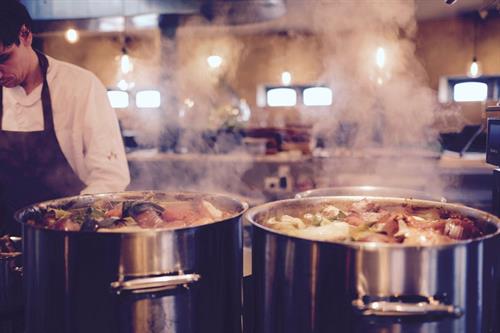(Almost) Everything You Need to Know to Start a Food Business in Missouri
You make that tasty treat that everyone just can’t get enough of … or maybe you’ve got the experience and the vision to start your own restaurant. You’re a culinary master … or at least passionate about making awesome eats or a tasty beverage.
And then it hits you: You could start a food business.
Now, we won’t sugar-coat this: A food business isn’t the easiest to start. Most ventures in this sector fail within the first year, according to the U.S. Small Business Administration.
So to give yourself the greatest shot at success, Xander Winkel of the Ennovation Center in Independence, Missouri, has outlined steps you should take to make sure you’ve done the market research, planning, financial calculations and more so you give yourself a better chance of tasting the fruits of your labors with a side of sweet success. (You can also catch him and other experts across the state giving talks about food businesses and more, so check out the calendar.) A few of those organizations are STL Foodworks, Creative Cookery, Salus Center Kitchen, COMO Cooks, UM Extension, Missouri Food Finder and Missouri Enterprise (Kansas City + NW Missouri, Rolla, Southeast Missouri, Southwest Missouri, St. Louis).
And the best thing is you don’t have to do this alone. Just give us a ring at 866-870-6500 or tell us what you need help with at this link, and we’ll whip up your very own Personal Action Plan that’ll outline the free and low-cost resources (like commercial kitchens, food business classes, market research, permits, etc.) across the state that can help your business cook up something tasty.

1. Evaluate the market
So you think you’ve got a great idea. Awesome. Now, it’s time to vet that idea and see if it’ll cut the mustard.
We hear this a lot from newcomers to the industry: “I had no idea how competitive the food industry was,” or “I didn’t realize how low my profit margins would be.” (By the way, Xander says the industry averages around a 5 percent profit margin.) So to limit the number of surprises you’ll encounter, it’s a great idea to evaluate the market and do your research before you buy that food truck, order that packaging or open that restaurant.
Visit your local library and see what resources and real actual people can help you test your concept, explore the opportunities, identify your competitors, reveal key trends and more. Often, they’ll have access to expensive databases that you can use for free to help you uncover those key facets.
And sometimes, this research will save you headaches, stress and lost money if you discover your idea likely won’t fly; at that point, you might’ve only lost time and might’ve even found a better strategy or idea than your original concept. Or you might discover that many restaurants similar to your concept have failed. Maybe you can improve where others faltered, or maybe it’s a sign that such an idea isn’t worth the squeeze.
[[CTA]]
2. Make money work
Make sure to run the numbers to ensure your idea has enough cash to sustain itself. That includes the cost of ingredients, cost of packaging, cost of labels, processing fees, distribution costs, startup costs (kitchen build, permits and licenses, product tests and development, equipment), operating costs (employees, kitchen lease, taxes, permits, insurance, vehicle, services) and your estimated revenue, which will be an educated guess—and hopefully a well-informed one.
Big questions to answer:
-
After doing all that math, are the numbers reasonable?
-
Have you factored in all your costs and potential future costs as you scale and sell in more stores?
-
How many units do you have to sell to just break even?
-
How much time until you break even?
If your operating and startup costs are higher than your estimated income, Xander recommends you either explore how you can save money or that you increase the price of your product. You can also take a look at some national averages to see how your costs compare.

3. Find a kitchen
You’ll likely need a commercially licensed kitchen at some point, so it’s good to factor in the location and requirements you’ll need to make your product.
Xander says before you lease a space, check with your local Health Department and see if it offers a free plan review. If you can provide the most complete picture of what you need in a space and how the space you plan to lease meets your legal requirements, the department can make suggestions and recommendations before you put your money down. Xander also says starting the assessment early will likely smooth out the process.
Did you know there are commercial food kitchens available in Missouri? Just give us a call at 866-870-6500 or hit us up here, and we’ll show you where you can cook up something great, like at the Ennovation Center.
4. Check Your Regulatory Requirements
You’ll need the correct tax IDs, county and city permits (that can get tricky), state entities, local health inspections, the correct information on your food labels, USDA guidelines (if applicable), etc.
And if you live in an area that straddles two states, you’ll likely have to file forms for both if, say, you own a food truck that will sell across state lines or if you’re a restaurant owner who plans to expand to the next state.
> > > This sounds tricky, and I’d like some help. Connect me with the Missouri organizations that can point me in the right direction, answer my questions and make sure my business has what it needs.

5. Get a label for food products
You must also make sure you’ meet the local, state and federal requirements for your food label (if applicable). This includes things like your company name, product, net weight, nutrition panel (if you sell more than $50,000 a year), best by date (in case you have a food recall, which means it’s a good idea to keep detailed records), ingredients (you’ll also note known allergens), bar code, etc.
6. Double-check your suppliers and distributors
Suppliers will deliver everything you need to make your product, so, yes, you’ll want a good price for what they deliver—but Xander says you should also investigate to see how reliable a prospective supplier is. Xander recalls an entrepreneur he knew found a great deal on jars but says the first order was wrong and the next came without lids; some jars were even broken.
A lot of this advice also goes for your distributors (aka, those people who deliver your wares). Time is money, especially when you have a perishable product, so working with reliable distributors and suppliers is definitely a top concern, no matter if you sell a food product or run a restaurant or food truck.
7. Don’t overlook certain costs
So you’ve got most of your costs calculated but have you also factored in those tiny costs for distribution? That includes gas (especially if you’re running a food truck), vehicle maintenance and the cost of storing your food.
Don’t overlook these expenses. Xander says some food business owners are puzzled why they don’t make a profit because they forget to factor in these key costs.

8. Get into stores
Putting your product in stores can be a great way to make your product more available to a bigger audience. That may be easier or harder, depending where you are in Missouri. For example, Xander says grocery stores in the KC metro are generally easier to work with than in other cities because they tend to have more flexibility with small businesses (that might include procurement, insurance, delivery requirements, etc.)
So your job is to find out who that decision-maker is and what you need to do to get your product in the store. Xander cautions against dropping your product off to a customer service rep … because it likely won’t get to the person who can give you the OK to sell your goods.
9. Plan your marketing
So you might see that word and think that you don’t have to market your product. Well, if you ever hope to be one of the food businesses that survives, you’ll have to.
You should create an authentic and memorable culinary brand that speaks to the emotions and the perception you want customers to link to your business. (Your logo and packaging are certainly part of that.)
Social media can help you monitor and discover the much bigger portion of what’s really your brand, like customer reviews and critic reviews (things you can’t control).
But just setting up a Facebook account won’t cut it. It’s what you do with that account that will determine the success strategy. Do you want to increase sales by 5 percent? You’ll need a clearly defined goal that you can act on and measure to reach your marketing benchmarks.
(Check out these other goal-setting strategies.)

10. Make your business scalable
What is your plan to scale your business? If you have a product, maybe you’re eying a wider distribution, locally, then regionally and nationally. Maybe you want to expand production to a factory instead of doing everything yourself.
If you’ve got a restaurant, you’ll need to hire employees to prepare and cook the food, servers to interact with customers, etc. Maybe you’re thinking about more locations across your region of Missouri or the entire state or the country. Maybe that means you want to franchise? Who will manage those other locations?
No matter the scenario, Xander says you want to make sure you’ve got the proper systems and training to ensure that the people who make up your brand are representing it how you’d want them to. That human capital is important to the success of your business.
Hungry for more information and guidance?
There’s plenty more where that came from. Just call us at 866-870-6500 or tell us a bit about what you need here, and we’ll show you your next steps (for free).











Leave a Reply